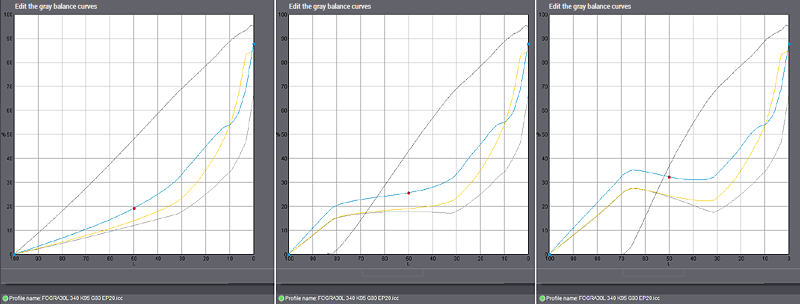'GCR setting/Black generation' Dialog
You can open this dialog by clicking "Modify" (GCR setting) in the "Generate profile" dialog.
This dialog lets you set the way black will be generated:
•either variable achromatic with conventional GCR
•or with "Black length" (starting point) and "Black width" as UCR.
Click "OK" to confirm your changes and close the dialog.
When you click "Default", the default settings are restored and the dialog closes.
Click "Cancel" to close the dialog and discard any changes to it. The last setting is restored.
GCR stands for "Gray Component Replacement". In this case, the chromatic inks are replaced by an appropriate amount of black. For example, 10 % cyan, 0 % magenta, 40 % yellow and 30 % black can be used instead of 40 % cyan, 30 % magenta and 70 % yellow to achieve the same color effect.
In contrast to UCR, replacement is in all tonal values and not just in dark parts.
GCR black generation saves costs through less chromatic ink consumption, stabilizes the print process and reduces drying issues.
You can have the following setting options:
•Less GCR in skintones
The human sense of vision is particularly sensitive where skintones are concerned. The black screen dots of GCR may be able to be dissolved by the human eye and appear like a gray fog. For that reason, this option lets you reduce black in skintones.
•GCR value
This lets you determine the amount of color that will be replaced by black. In the example above, a maximum of 30 % black is used for replacement if you select a GCR value of 100 %. For example, if you set a GCR value of 50 %, then only half of the possible color is replaced. In other words, the following applies to the example above: 25 % cyan, 15 % magenta, 55 % yellow and 15 % black.
You can set a value for GCR between 10% (minimum GCR) and 100% (maximum GCR) using the GCR slider.
Note: You define a starting point for GCR with the "Starting point K[%]" slider (see below).
·"Min. GCR": The minimum setting "10%" corresponds to normal chromatic reproduction with skeleton black.
·"Max. GCR": The maximum setting "100%" corresponds to the greatest possible achromatic reproduction. In this case, no position in the image (except in the darker image areas) has more than two chromatic inks plus black or only black in the neutral gray image areas.
·In practice, a setting between 50% and 70% is usual.
With a GCR of 100%, the black screen can become very noticeable in gray in amplitude-modulated screening (there is no longer a screen rosette there).
•Starting point K[%]
In lighter areas, a replacement by black is possibly not wanted. In this case, enter the minimum value for black, as of which replacement will apply. Replacement is always done if a value of 0 % is set.
For example, if you select a starting point of 35 %, then there would be no replacement in the example above and the colors would remain unchanged.
Values between 0 % and 40 % are possible for the starting point.

Example: Gray balance as seen in ICC profiles with 80% GCR and three different starting points
(0%, 20%, and 35%)
·Left starting point "0%": Black is applied immediately depending on the GCR setting.
·Center starting point "20%"
·Right starting point "35%": This shows that non-monotonic gray balance curves can occur with a high GCR value (greater than 70%) and a high starting point (greater than 30%).
Note: A starting point between 10% and 15% has proved to be successful especially if fashion shots with many light skin tones have to be reproduced with GCR. In this case, GCR starts only when cyan reaches 10% to 15%, thus avoiding light skin tones from being generated with black.
Black generation with length and width
In under color removal (UCR), cyan, magenta and yellow are reduced in favor of a corresponding amount of black at dark and neutral points in the image.
•Black length
Black length specifies the tonal range that is possible for replacement by black. Black is printed only in the shadows ("skeleton black") if the minimum value of "2" is set. The higher the value, the greater the number of tonal values affected by replacement. You have a long black in position "10". In other words, some of the chromatic colors will be replaced by black in all the tonal values.
Black length can also be achieved through the starting point of black. This is 80 % for skeleton black. A replacement by black is done only if the black value is a minimum of 80 %. Long black is equivalent to a starting point of 0 %.
•Black width
With black width, you define the color saturation, up to which replacement will be done. A value of "0" means that only grays will be affected. By contrast, the whole color space is included if a value of "5" is set.
An optimal black is calculated by Color Toolbox on the basis of the settings for "Black length" and "Black width" and the information taken from the color data.
Stabilized Gray Axis of Selected Black
Selecting this option, regardless of the other settings, creates an area directly on the gray axis with a minimum CMY. This avoids the risk of a color cast in grays even if there are process fluctuations and displays these areas reliably in neutral gray.